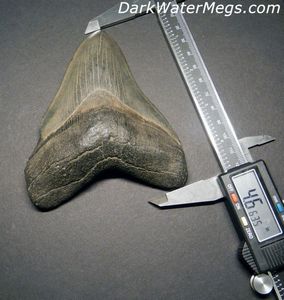How to Measure a Fossilized Shark Tooth
Multiple measurements of a megalodon tooth
A very common question is "how do you measure a shark tooth?"
In this article I will try to give a brief summary of how megalodon teeth are measured.
Why the size of a shark tooth or megalodon shark tooth is so important
Size of a megalodon tooth or other fossilized shark tooth is important because it not only is a factor when determining value but is a metric for comparison and way to estimate the total size of the shark.
Size of a shark tooth is important for some of the same reasons as a trophy fish size is important or the distance of a world record setting long jump is important.
You can read more about how the size of a shark tooth influences value in my article on How Much Is A Megalodon Tooth Worth?
The Standard
The size of megalodon teeth is measured primarily in inches although outside the US it is common to use cm/mm, but for the most part people use inches as a unit of measure. The size of a tooth refers to the length, more specifically the length from the tip of the tooth to the top of either root also known as "slant height". This form of measurement is the standard for measuring teeth and is the assumed method when discussing tooth size.
Slant Height = The distance between the point or serrated tip of the shark tooth and the top of either root.
Width = The widest part of the tooth when laid down flat
Two Measurements
Because the tooth has two measurements (one from the tip to the right root end, and one from the tip to the left root end) people will sometimes list two measurements such as L1=4.851" and L2=4.663" this means that from the tip to the top of one root was 4.851" and the measurement from the tip to the other root end was 4.663"
Sometimes the measurements are identical and sometimes they vary considerably; however, the larger of the two slant heights is considered the overall size of the tooth.



How to Measure a Megalodon Tooth
If you are simply curious as to how big a megalodon tooth is you can place it on a ruler and get a rough idea of the slant height. However, if you need a precise measurement to determine if your megalodon tooth reaches a benchmark such as being over the 5" or 6" mark you may need to be more precise.
The best practical way to get a precise measurement on a megalodon tooth is to use a digital caliper, opening the caliper jaws to approximately the same size as the slant height of the tooth you wish to measure. Then make small adjustments until the caliper just touches the serrated tip of the tooth and the root, from here check your adjustment by holding the caliper still and moving the tooth, if the tooth can move freely between the jaws of the caliper you need to reduce the distance. The caliper must be in contact with the root and the tip of the shark tooth for an accurate reading.
the slant height of the tooth you wish to measure. Then make small adjustments until the caliper just touches the serrated tip of the tooth and the root, from here check your adjustment by holding the caliper still and moving the tooth, if the tooth can move freely between the jaws of the caliper you need to reduce the distance. The caliper must be in contact with the root and the tip of the shark tooth for an accurate reading.
Additionally to measure width one will use the same method above except instead of measuring from the tip to the root the widest part of the tooth is measured.
Weight
A common statistic on teeth that is often offered is weight, the reason this is done is that it is an easy statistic to gather, unfortuantely it has little bearing and can be easily manipulated. For instance a freshly found 6" tooth can weight in well over 1lb 8oz, however when that tooth dries over the course of several months it can lose up to 35%+ of the initial weight. Also things like barnacles, caked on dirt and mud, plant life, and other things attached to the tooth can significantly change the weight. For that reason weight is not seriously considered as a significant factor by shark tooth collectors.
Fuzzy Numbers
When size counts so much it is often a cause for people to use unscrupulous practices when measuring shark teeth. When a 5" shark tooth is worth significantly more than a 4.91" shark tooth people will often resort to using sloppy measuring or listing practices. Fractions are often used to inflate the size of a tooth, for instance a tooth that measures 5.69" will be listed as 5 and 3/4". People using standard rulers will often push the tooth to just inside the starting measurement mark and visually round up in order to squeeze the last .092" in order to list the tooth as a 6" instead of the 5.9" it actually is.
When listing or selling shark teeth people will often use words to further complicate things such as "Nearly 6" megalodon tooth for sale" when in reality the tooth is 5.8". Other things to watch out for are people using off the wall measurements such as diameter instead of slant height, etc.

Shark tooth size is most commonly used when a tooth is being bought or sold, it helps communicate a characteristic of the tooth between the buyer and the seller, it has a bearing on value and rarity. As long as the buyer and seller are both using the same criteria to understand the measurement of a megalodon tooth and the same unit of measure there should be no misunderstandings or people being mislead.